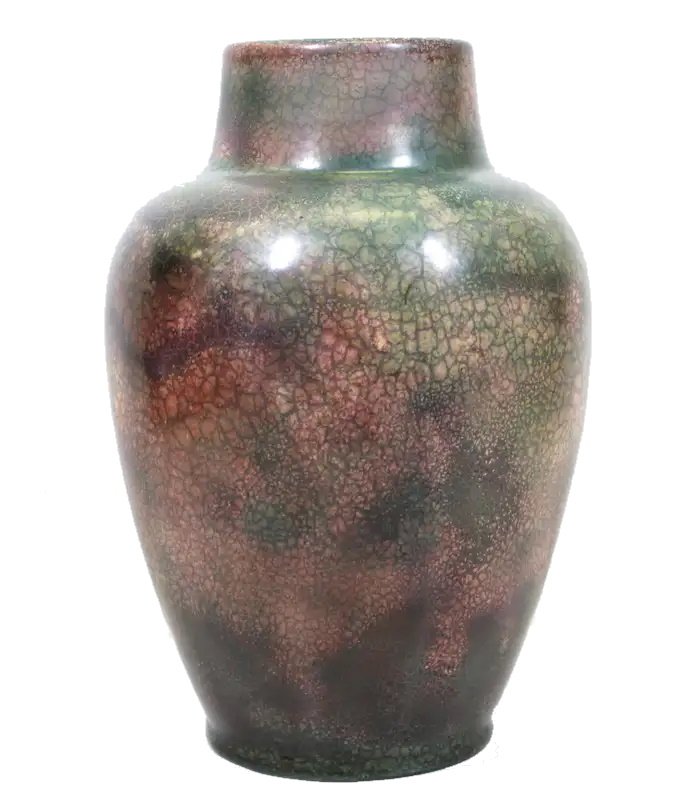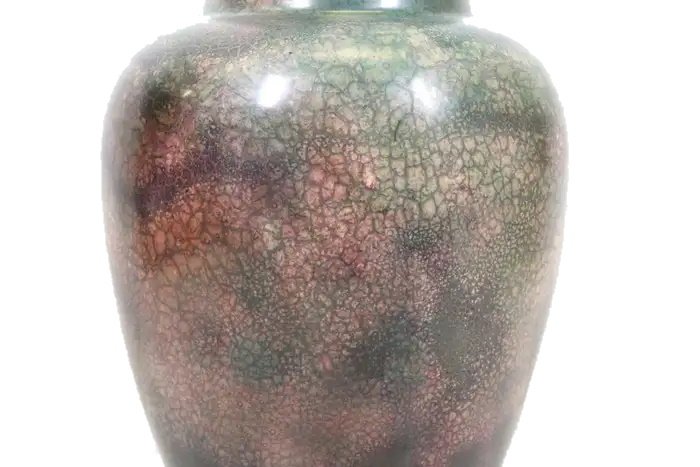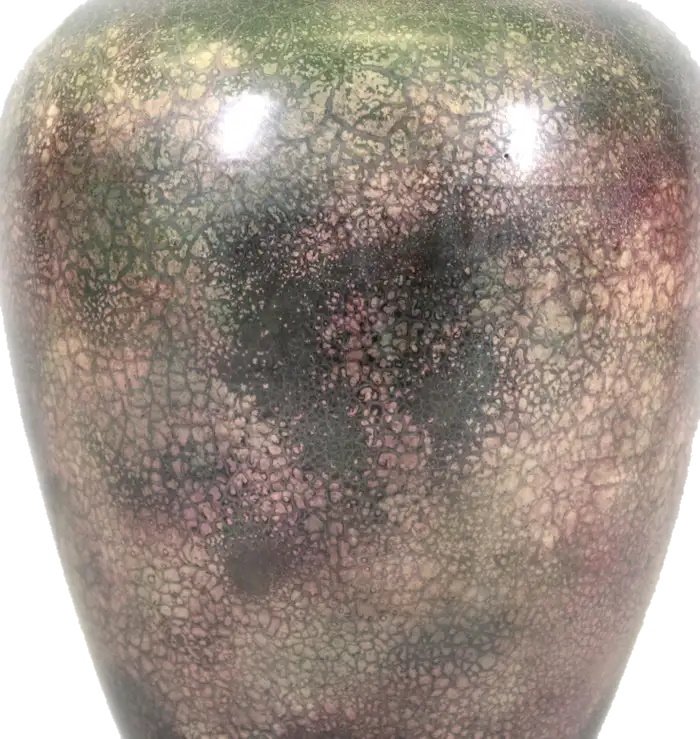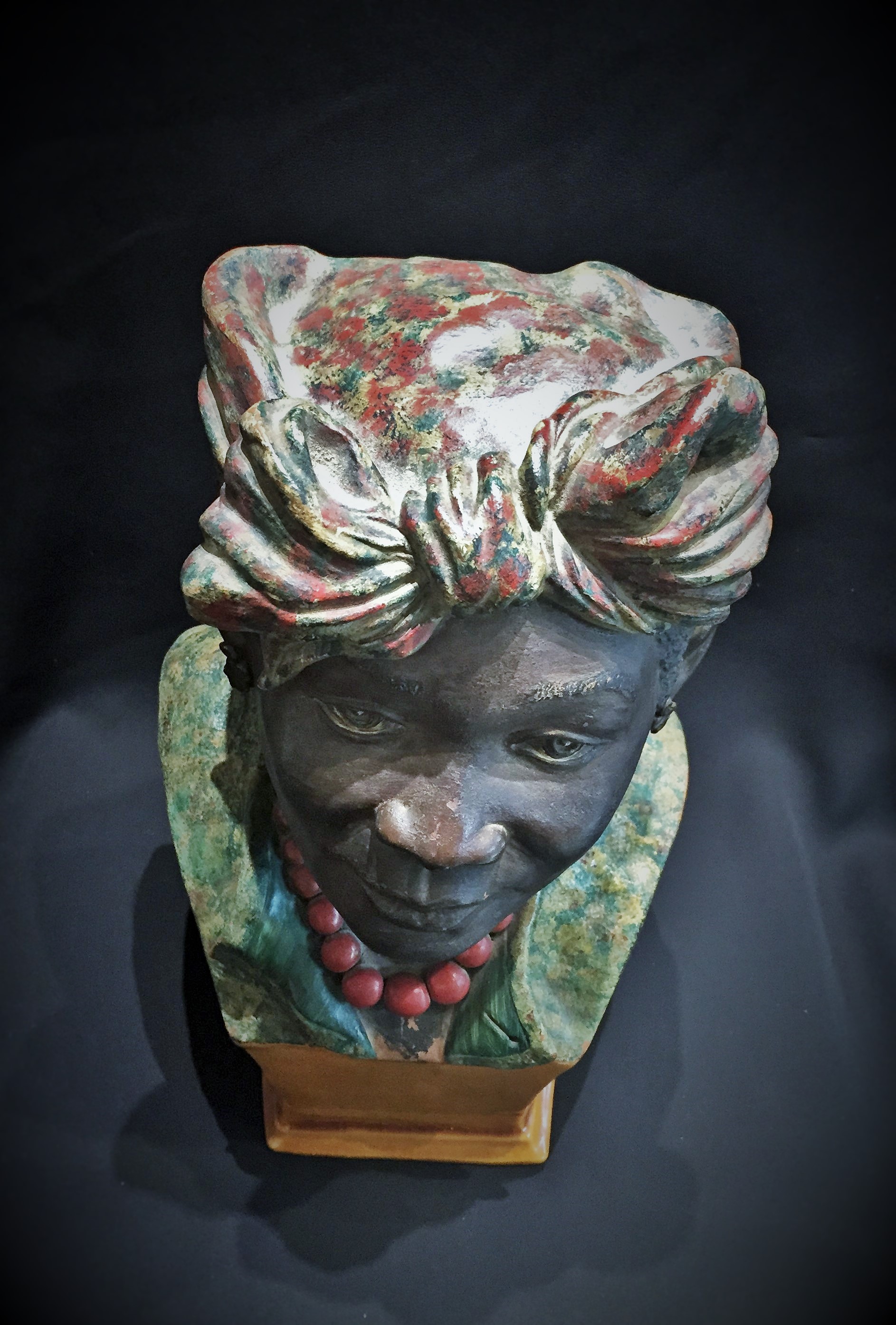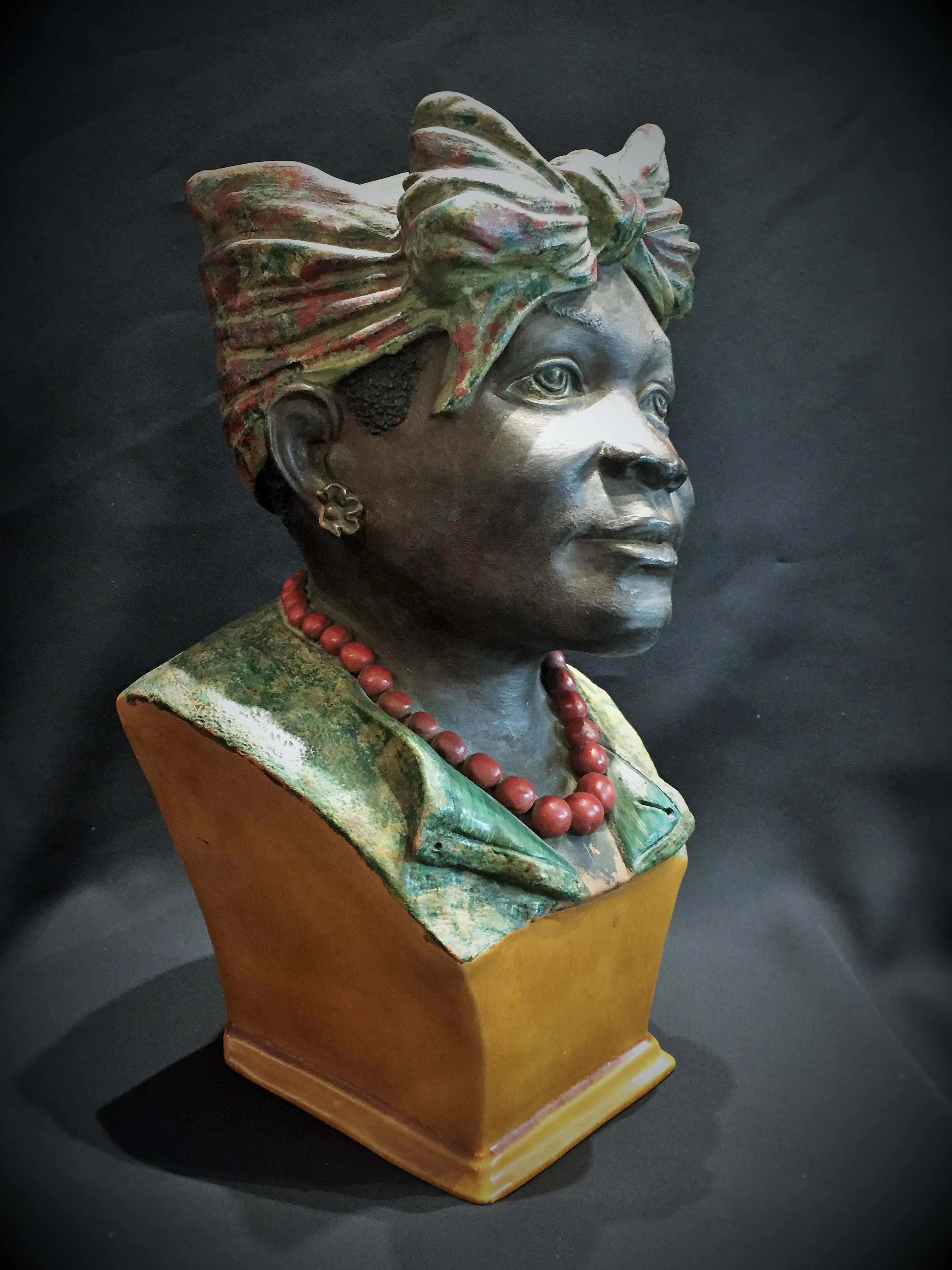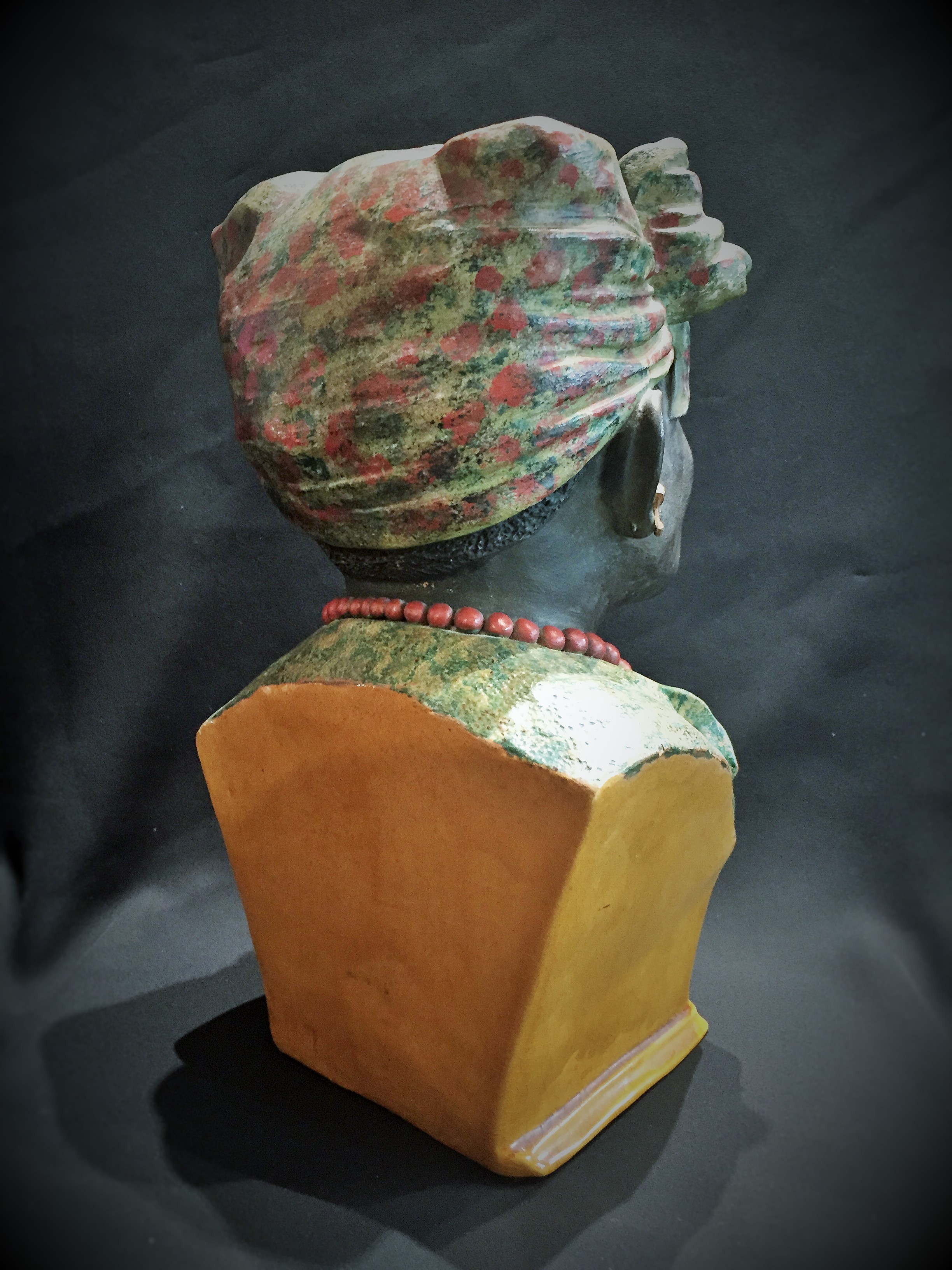american Contemporary Art
Vicky Choke
Fantasy Chair
Painted Ceramic
Ca. 1990
This unique little ceramic sculpture by renowned American Ceramist, Vicky Choke depicts a fantasy chair with a plate of Chinese Jelly Dumplings on the upholstered seat,
DETAILS
Signed on bottom,
Fine condition.
DIMENSIONS
Height: 6.5 inches Width: 3 inches Depth: 3.5 inches
ABOUT ARTIST
Vicky Chock is a renowned American ceramist celebrated for her whimsical and culturally rich ceramic sculptures. Born in 1943, she earned her Master of Fine Arts from Claremont Graduate University before relocating to Hawaii, where she became a professor of art at Leeward Community College.
Chock's work is deeply influenced by her studies in China and the art of the Tang Dynasty, which is evident in her figurative sculptures that often depict serene, smiling women adorned with symbolic elements like fish and teapots. Notable pieces include "Chinese Lady Serving Fish" and "Chinese Lady Tea Server," both created around 1990.
Her sculptures are characterized by a blend of humor, cultural storytelling, and architectural elements, as seen in works like "Balancing Act w. Pear" and "Chair with Pagoda." Chock's art has been featured in various galleries, including Cedar Street Galleries in Honolulu, Hawaii, and has been available through platforms like 1stDibs and eBay.
Chock's contributions to ceramic art have made her a significant figure in the American ceramics community, with her pieces being sought after by collectors and art enthusiasts alike.
$1,900
French Art Deco
Attributed to:
Sevres
Vase
Stoneware | Green Celadon
Circa 1925
DIMENSIONS
Height: 11.5 inches (29.21 cm) Diameter: 9 inches (22.86 cm)
DETAILS
Marked 'E' on the bottom.
ABOUT VASE
This exquisite French Art Deco vase, crafted from high-fired stoneware in a striking celadon green glaze, is attributed to the renowned Sèvres porcelain manufactory. The vase, dating from the mid-1920s, features a beautifully intricate sculptural relief that exemplifies the sophisticated design sensibilities of the era. Made in France, this piece is a testament to the exceptional artistry and craftsmanship characteristic of the Art Deco period.
$4,300
Italian Modernism
Whimsical Vase
Glazed Ceramic with Gold Embellishments
Ca. 1940s
DIMENSIONS
Height: 17 in (43.18 cm) Width: 9 in (22.86 cm) Depth: 7 in (17.78 cm)
DETAILS
Old illegible label on the bottom is present.
ABOUT PAINTING
Italian post-war modernist whimsical glazed ceramic anthropomorphic vase featuring intricate hand-painted gold embellishments. Crafted in Italy during the 1940s-1950s, this charming piece showcases a rich aubergine-purple hue.
$2,500
American Art Deco
Edith Varian Cockroft
Charger Plate
Ceramic
Circa 1930
DIMENSIONS
Height: 1 inches (2.54 cm)
Diameter: 10.75 inches (27.31 cm)
ABOUT
Art Deco glazed ceramic charger plate in Persian blue and gold, made by Edith Varian Cockcroft (American 1881-1962). The piece presents a hand-painted and gilt center with a pair of blue trees and an exotic female dancer holding cymbals. Made in the United States during the 1930's, the piece has a 'Cockcroft' signature on the back and is in remarkable antique condition.
EDITH VARIAN COCKROFT (American, 1881 – 1962), famous American modernist was born in Brooklyn New York to wealthy parents and would spend her formative years living with them living in Allendale, New Jersey.
Edith Varian Cockcroft was a woman of many talents, who first found success in painting before pursuing a second rewarding career in the textile industry and later applying her creativity to the world of ceramics. She studied briefly with William Merritt Chase before going abroad to Paris in 1898, where she befriended Henri Matisse, Paul Gauguin and Pierre Auguste Renoir, all three of whom would influence the direction of her work.
By 1908, Cockcroft was dividing her time between Europe and New York City, and occasionally ventured to sites in New England, including Maine and Provincetown, in search of subject matter. Whether painting harbor scenes, still lifes, nudes, or figural compositions of American and European towns, Cockcroft’s bold palette and dynamic painting style, as well as her choice to sign without using her first name, sometimes led critics to assume her work was created by a man.
Around 1914, Cockcroft was married to Charles Weyand, and the two resided in a midtown Manhattan apartment for several years before misfortune hit and his business failed, just prior to America’s involvement in World War I. Rather than return to her family while he worked to regain their footing, as Charles suggested, Cockcroft insisted on helping in their recovery and began experimenting with painting batik patterns on silk.
Her efforts in this new endeavor were rewarded; her designs and garments came to be in high demand and soon numerous seamstresses and artists were in their employ. With Charles leading sales and marketing, Cockcroft was able to focus on the creative side, and in 1921 she envisioned and soon patented a process for printing patterns on silk for blouses and other garments, while retaining their hand-made appearance. This lucrative idea brought sizable royalties, allowing the artist to resume her love of travel and return to her individual artistic pursuits while Charles managed the affairs of their company.
In her later years, Cockcroft, who was also known as Edith Varian Wyland and Edythe Varian Cockcroft, would travel to Haiti where she would paint several paintings using the Haitian people and their local color as a subject.
In 1962, Edith Varian Cockcroft died in Ramapo, New York. A fire in her studio had destroyed a large number of her paintings, and in the 1990s, a large number of her works were found, having been rescued from a trash compactor.
$3,300
American Arts & Crafts
Chinese-Form | Pauleo Pattern
Flower Vase
In Manner of Roseville for Tiffany
Glazed Ceramic
Circa 1900
DIMENSIONS
Height: 15.75 inches (40.01 cm)
Diameter: 10.5 inches (26.67 cm)
ABOUT VASE
A rare American Arts & Crafts ceramic vase in the Chinese form, showcasing the distinctive craquelure technique, crafted by Roseville and retailed at Tiffany. This exceptional piece features the Pauleo pattern and was meticulously made in the United States around 1900. Adorned with a variety of glazes, including lustres, matte mottled colors, and semi-gloss blends, it still stands as a testament to exquisite craftsmanship.
$2,900
Japanese Art Nouveau
Flower Vase
Awaji Ware Art Studio Pottery
ca. 1900s
DIMENSIONS Height: 9-3/4 inches Width: 4-3/4 inches Depth: 3-5/8 inches
ABOUT AWAJI WARE ART STUDIO POTTERY
Awaji pottery was made on the Japanese island of the same name between 1830 and 1939. Most of the pieces that we see here in the West were made sometime between the mid 1870's when Awaji began exporting pottery, and the mid to late 1930's when the last of the kilns closed. Awaji pottery comes in an abundant variety of shapes, colors, and decorative techniques. The glazes are often brilliant in tone and most are translucent and finely crackled. The ware is sometimes mistaken by the uninitiated for European majolica or American art pottery. Unlike majolica and the vast majority of Western art pottery, most Awaji pottery is robustly hand-thrown, with only small and complex forms molded. Some of the earlier ware is delicately potted, but the majority of Awaji-ware is more stoutly constructed and pleasantly balanced. The Awaji potters were masters of their craft who had an innate feel for the possibilities of the clay form. The result of their efforts is a pottery of exceptionally lively forms that have an informal and genuine feel, devoid of fussiness and pretension.
The ceramic body (or paste) is made of high-fired, white or cream colored clay that borders on stoneware. The formula apparently changed over time and varied from pink or buff, to white to grey. The glazes are lead based which gives the colors brilliance and makes the translucent enamels glassy and often iridescent. The most common Awaji glaze colors are a grass green, yellow that can range from pale lemon to deep amber, cobalt blue, and aubergine (a shade of very dark purple). Other glazes are a light green, dusty blue, light and dark turquoise, mirror-black, and burgundy. The Awaji potters were adept at creating unadorned monochromes, two-tone glazes, three-color glazes (sancai), incised decoration (most commonly featuring irises), and applied relief decoration.
$1,200
Japanese Art Nouveau
Flower Vase
Yellow Ceramic
ca. 1910
DIMENSIONS
Height: 11.75 inches Diameter | Neck: 3-7/16 inches Diameter | Max.: 5.5 inches Diameter | Base: 4.25 inches
ABOUT
Art Nouveau's style and ideology were developed in response to the need for a new approach to art and design at the end of the 19th century. This wonderful Japanese glazed yellow ceramic floral vase with many of most unusual geometrically-shaped handles is an example of how the influence of Japanese art and Japonisme, which was a major source of inspiration for the art and design world of the time, formed the backbone of this trend. In its turn, the popularity and global development of the movement had defined a very specific aesthetic direction and provided a new creativity impulse to many artists of all genres in its country of origin, Japan; where Art Nouveau encouraged artists to transcend art and design genres, and to reevaluate traditional crafts and design, activities that can be said to be the starting point for modern Japanese craft design.
SOLD
French Art Nouveau
Ocean Life Theme
Vase | Cachepot
Iridescent Stoneware & Patinated Bronze Crab SCULPTURAL Appliqué
ca. 1900s
ABOUT
We present here a most unusual and utterly decorative French Art Nouveau Iridescent Stoneware Vase or Cachepot w/ Ocean Life Theme & Bronze Crab Appliqué, created ca. 1900s. This piece of art features an absolutely outstanding composition depicting a stormy sea wave carrying a crab on its crest.
DIMENSIONS Height: 14 inches Width: 9.75 inches Depth: 12.5 inches
$5,400
Austrian Art Nouveau
Jugenstil
Paul Dachsel for Turn Teplitz
Ceramic ‘Fern’ Vase
ca. 1900
DETAILS: Fully marked on bottom.
DIMENSIONS: Height: 6.75 inches Width: 4.5 inches Depth: 4.5 inches
ABOUT THE ARTIST
Paul Dachsel (Czech, born circa 1880) was the son-in-law of Alfred Stellmacher, the founder of Amphora Pottery company in Turn-Teplitz, then in Austria. Very little is known or was written about Dachsel. He served as a designer at Amphora from 1893 until 1905. There, he was instrumental in creating new motifs and designs inspired by the voluptuous, organic Art Nouveau style, as well as incorporating Japanese shapes, such as the sake bottle, to a traditional Victorian vase body. Very soon, most of the vases had converted to Art Nouveau in shape and decoration. In 1905, Dachsel founded his own pottery studio, Kunstkeramik Paul Dachsel. He continued to draw inspiration from Art Nouveau and created designs that favored simple forms elaborated with applied handles, rims, and ornaments. In many examples, he favored tertiary colors and folded, flat, and soft-edged shapes, giving his work a fairy-tale quality. Dachsel’s ceramic studio remained in business until 1911.
SOLD
Japanese Art Nouveau
Awaji Ware Art Studio
Ceramic Flower Vase
ca. 1900
DIMENSIONS: Height: 12.5 inches Width: 6.75 inches Depth: 6.75 inches
ABOUT AWAJI POTTERY
Awaji pottery was made on the Japanese island of the same name between 1830 and 1939. Most of the pieces that we see here in the West were made sometime between the mid 1870's when Awaji began exporting pottery, and the mid to late 1930's when the last of the kilns closed. Awaji pottery comes in an abundant variety of shapes, colors, and decorative techniques. The glazes are often brilliant in tone and most are translucent and finely crackled. The ware is sometimes mistaken by the uninitiated for European majolica or American art pottery. Unlike majolica and the vast majority of Western art pottery, most Awaji pottery is robustly hand-thrown, with only small and complex forms molded. Some of the earlier ware is delicately potted, but the majority of Awaji-ware is more stoutly constructed and pleasantly balanced. The Awaji potters were masters of their craft who had an innate feel for the possibilities of the clay form. The result of their efforts is a pottery of exceptionally lively forms that have an informal and genuine feel, devoid of fussiness and pretension.
The ceramic body (or paste) is made of high-fired, white or cream colored clay that borders on stoneware. The formula apparently changed over time and varied from pink or buff, to white to grey. The glazes are lead based which gives the colors brilliance and makes the translucent enamels glassy and often iridescent. The most common Awaji glaze colors are a grass green, yellow that can range from pale lemon to deep amber, cobalt blue, and aubergine. Other glazes are a light green, dusty blue, light and dark turquoise, mirror-black, and burgundy. The Awaji potters were adept at creating unadorned monochromes, two-tone glazes, three-color glazes (sancai), incised decoration (most commonly featuring irises), and applied relief decoration.
ABOUT AWAJI ISLAND
Awaji is an island in Japan’s inland sea between Honshu, the largest of Japan’s four main islands, and Shikoku, which is the smallest. The island is known for its beautiful scenery and quaint fishing villages which have attracted artists seeking retreat and inspiration for centuries. There is a renowned puppet theatre, ningyō jōruri, which performs traditional dramas on the island which has traveled internationally. The narrow channel between Awaji and Shikoku is the site of the dramatic Naruto whirlpools featured in Japanese legend, which are caused by the tidal flow in and out of the inland sea. Awaji is now connected to Honshu by the Kobe-Awaji Bridge, which is the longest suspension bridge in the world.
ABOUT AWAJI KILNS
The first kiln on Awaji was started in 1831 by a doctor named Minpei in the village of Iga. Minpei was an energetic man of some means with wide ranging interests. He is known to have been a doctor, a talented writer, a renowned chajin (tea ceremony master), a soy sauce factory owner, and run a large fishing cooperative before devoting all of his energies to ceramic manufacture. In 1834, Ogata Shuhei, a highly esteemed Kyoto potter, came to work with Minpei for two years. A wide variety of fine wares were made in the fifty years which followed. The kiln was known for fine Satsuma-type pieces in the Kyoto or Awata style with elaborately glazed geometric designs and aptly executed foliage and wildlife. Minpei also mastered underglaze-blue decoration, carved celadons, ceramics that cleverly imitated bronze vessels, and bright yellow and green monochromes with incised designs. In 1842, the provincial Daimyo, or Governor, came to visit the operation and granted Minpei an official kiln status. Minpei retired in 1862, leaving the kiln to his son Rikita and nephew Sanpei.
By the 1870's, Rikita and Sanpei were each running kilns of their own and exhibiting in the International Exhibitions, where their wares were well received. In the late 1870's, Christopher Dresser, the influential British designer, visited the two kilns and ordered examples of each to be shipped back to England for study. In 1883, Rikita sold his works to a group that called the kiln Danto—which means “Group” in Japanese. Though Sanpei did not begin production at his own kiln until about 1870, his operation quickly became the larger of the two. A third kiln was set up in Awaji's capital, Sumoto, in 1883 by Tamura Kyuhei.
Some of the artists in Awaji evidently maintained a relationship with their counterparts in Kyoto. Pieces from each region continued to share similar raw materials and processes as well as nearly identical forms, glazes, and decorative techniques. They each used cream colored pottery clay with brilliant enamel glazes, fired to approximately the same temperature. Each used the point bottle form and the popular squared buttress handle form.
Through the 1880's and 90's, the Danto and Sanpei kilns, evidently influenced by their clients in the West, began to shift their styles. As the export market developed Awaji pottery evolved from a distinctive regional style intended for domestic consumption to a pottery influenced by international tastes and markets. Despite this influence from outside pressures, the Awaji pottery retained its unique regional flavor. The forms became simpler and more organic; the decoration parsed to a spare and bold, but still spontaneously confident manner. Bright green, yellow, and blue glaze grounds were used both as monochromes to show off the forms, or as grounds under carved, incised and applied decorations highlighted with other blending and contrasting colors.
The Awaji potters were obviously aware of the International art movements of the late 19th and early 20th centuries. In response to the Art Nouveau style they used sensuous, organic, forms with sweeping curves and handles. These forms were accented by two tone glazes which melted into one another with hypnotic effect. These forms gave way to the boldly geometric style of the Art Deco movement. These are characterized by architecturally squared buttress handles and feet, along with rocket and other space-age forms. The Deco then gave way to the Modern Movement. The pieces made during this last long movement are some of the most interesting of the Awaji output.
During this final period (1922 - 1939), Sanpei's kiln produced an impressive array of extremely creative art pottery. A number of new glazes were developed, many of which are now used in striking flambé mixes. The two kilns closed in 1939 as the export market dropped off preceding World War II.
$2.200
Austrian Art Deco ~ Streamline Modernism
Walter Bosse
Orange Rabbit
Ceramic Sculpture
ca. 1930
DIMENSIONS
Height: 8 inches Width: 5 inches Depth: 8 inches
ABOUT ARTIST
Walter Bosse (Austrian, 1904 – 1979) was a Viennese artist, designer, ceramist, potter, metalworker, and craftsman noted for his modernist bronze animal figurines and grotesques.Walter Bosse was the son of artists Luise and Julius Bosse. His father worked as a portrait painter at the imperial court.Walter Bosse attended the Wiener Kunstgewerbeschule, , now the University of Applied Arts Vienna from 1918 to 1921, where he studied ceramics under Michael Powolny, and ornament under Franz Cizek. He then attended the Munich School of Applied Arts (Münchner Kunstgewerbeschule). During his schooling he was given the opportunity to sell his work at the Wienner Werkstatte by Josef Hoffman, who became a mentor to Bosse. Bosse opened his own shop in Kufstein, in 1923.
Bosse's work grew in popularity and a number of his pieces were shown at the International Exposition of Modern Industrial and Decorative Arts in 1925. He started designing for Augarten Porcelain Works (1924), as well as Goldscheider (1926) and Metler and Orloff (1927). In 1931, to meet increasing demand (especially in America), Bosse opened up a bigger shop in Kufstein, but by 1933 he started to feel the effects of the economic depression. By 1937, the Kufstein works were closed. In 1938, now divorced, Bosse moved back to Vienna, where he founded Bosse Ceramics (Bosse-Keramik), which expanded under the new name “Terra” to include glass, toys, textiles and a variety of craft items for the gift market. In the late 1940s, Bosse began experimenting with brass by giving his ceramic figures a metal coating to protect them from breakage.
He formed a partnership with Herta baller, whose company (the Herta Baller Company) manufactured and marketed the brass figurines, this collaboration was called the Bosse/Baller company. In the early 1950s, Bosse and Baller began exploring a new style of brass called the “Black Gold Line” or "Black Golden Line" of brass figurines. He transitioned all of his efforts to brass and the figures became popular worldwide. Despite Bosse's success with his brass figures, it was still a difficult time for him financially. In 1953, partly fleeing from financial troubles, he moved to Iserholm, Germany where he set up a new shop and continued production. In Vienna, the Herta Baller Company continued to make and sell Bosse's designs. Bosse also collaborated with Karlsruhe State Majolika Works on a number of pottery animal figures.]
In 1958, he designed for Achatit Schirmer in Cologne. Bosse also turned his efforts to small, everyday items such as letter openers, keyrings, corkscrews, and pencil holders, all of which bear the distinctive "black and gold" look. A number of Bosse's designs began to gain widespread popularity internationally, particularly his brass hedgehog ashtrays and hand-shaped bowls. But the designs' success led to forgeries popping up worldwide. His hedgehog ashtrays were reproduced by many forgers in various countries and with varying degrees of precision. To protect his designs, he engaged in court battles which would last the rest of his life and deplete most of his money. Because of these cases, he is considered to be a seminal figure relating to modern copyright law for designer goods.
The last years of Bosse's life saw him devoting much of his time and money to his legal disputes and on December 13, 1979, Bosse died with no money to his name in Iserlohn, Germany. His oeuvre consists of about 8,000 models and designs, of which about 3,000 are ceramics.
SOLD
ITALIAN ART DECO
GIO PONTI
for Salvatore Saponaro & richard-ginori s.cristoforo, milano
THE TIRED PILGRIM
ENAMELED EARTHENWARE SCULPTURE
ca. 1925
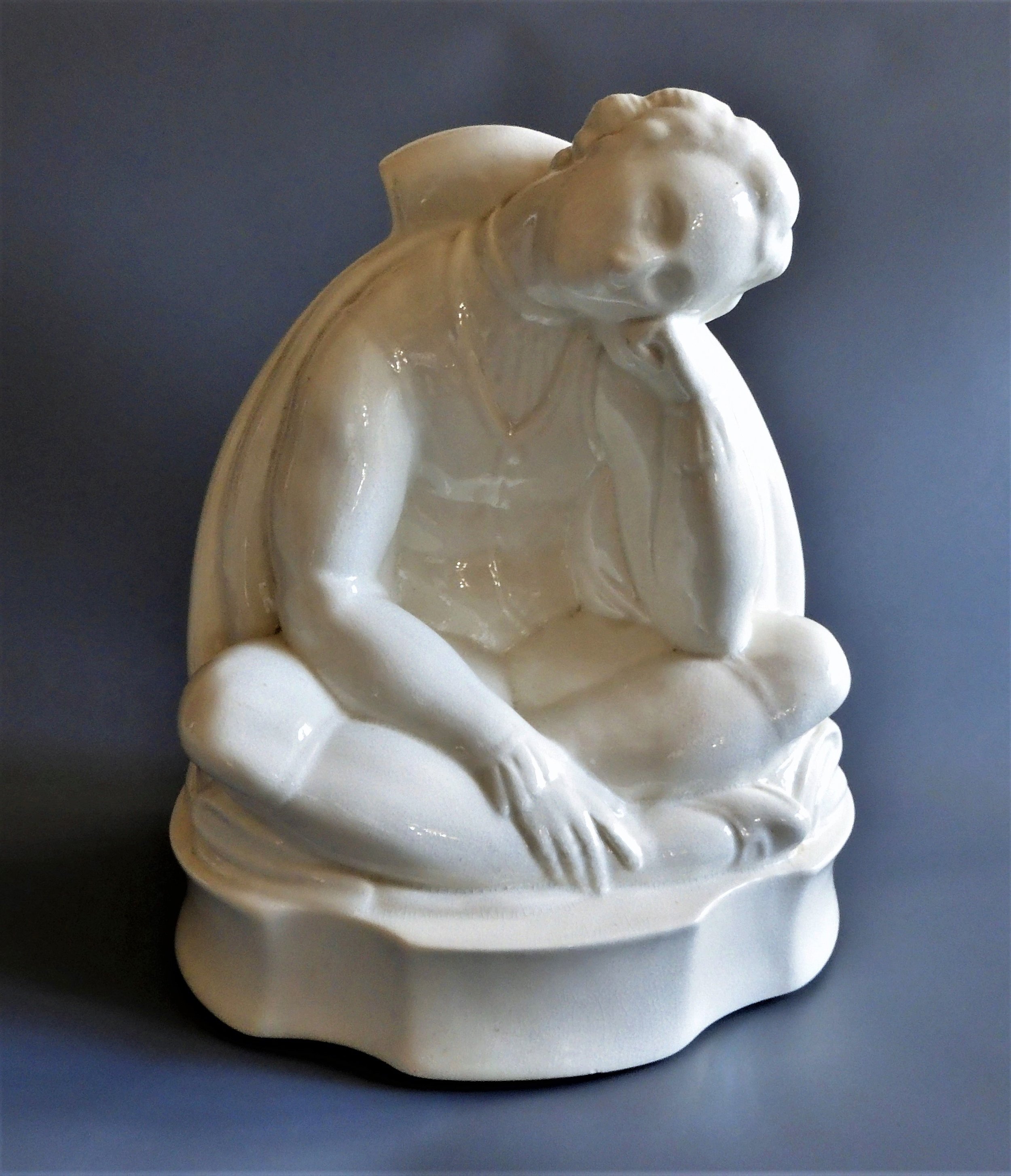
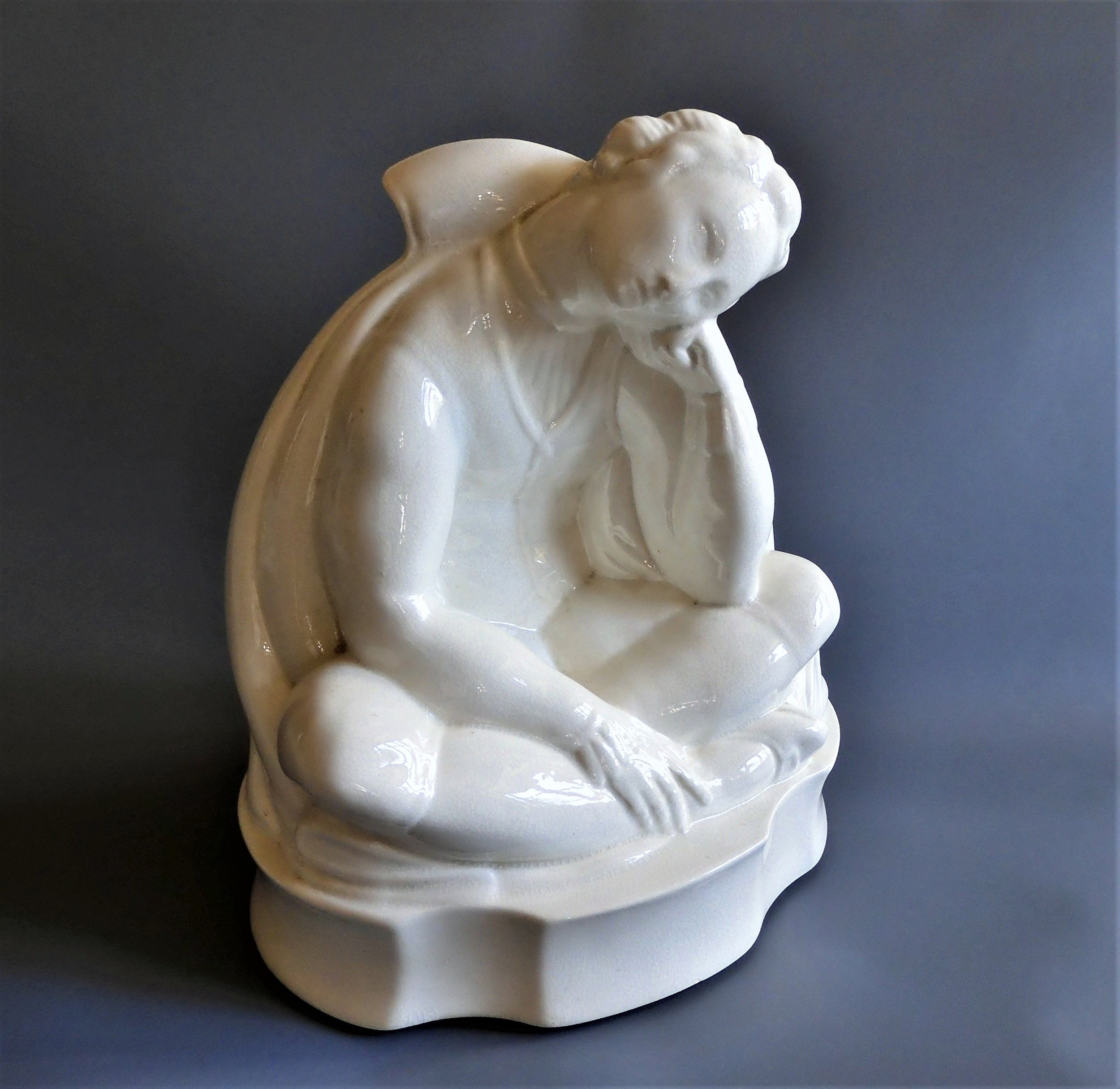
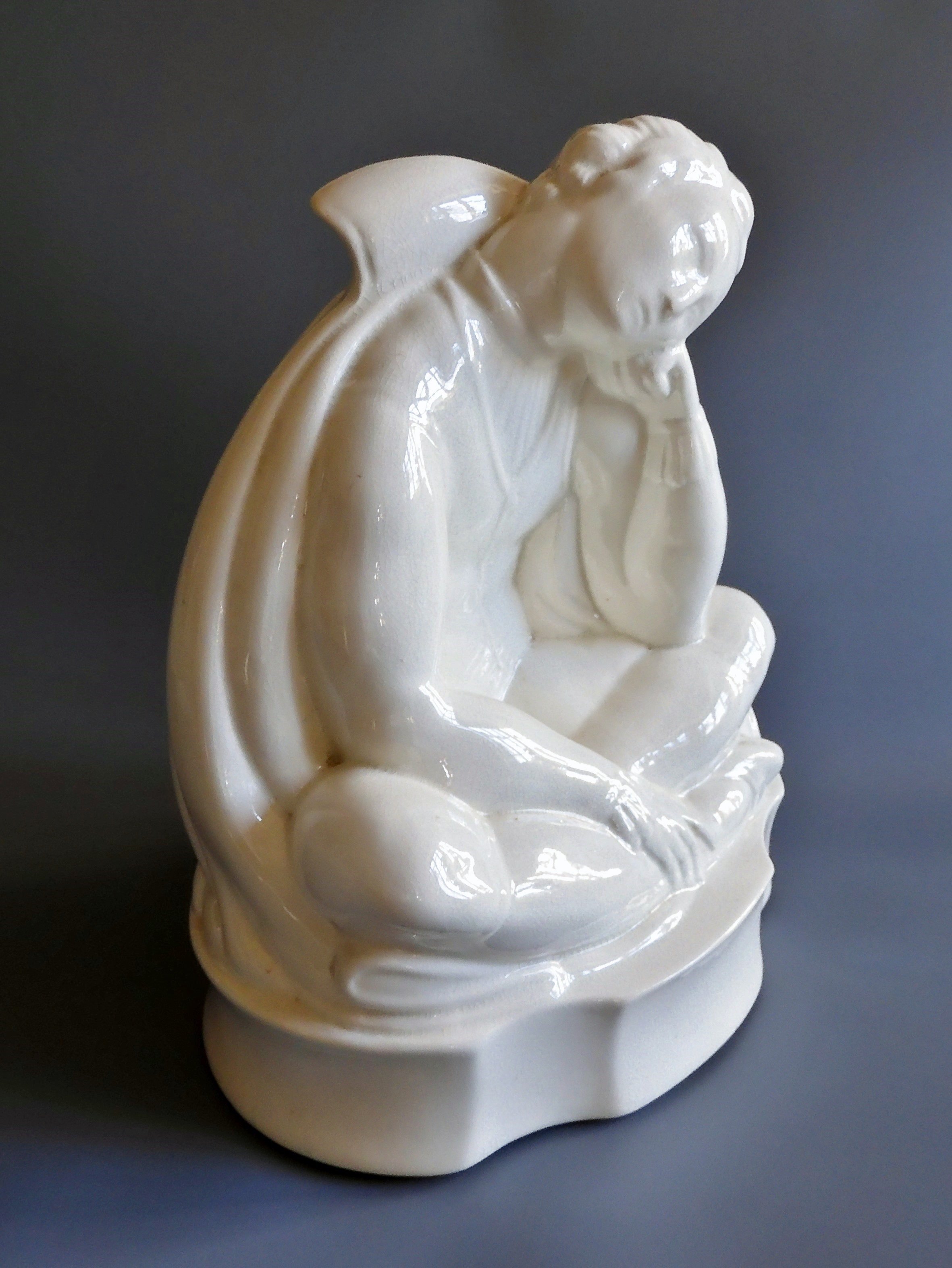
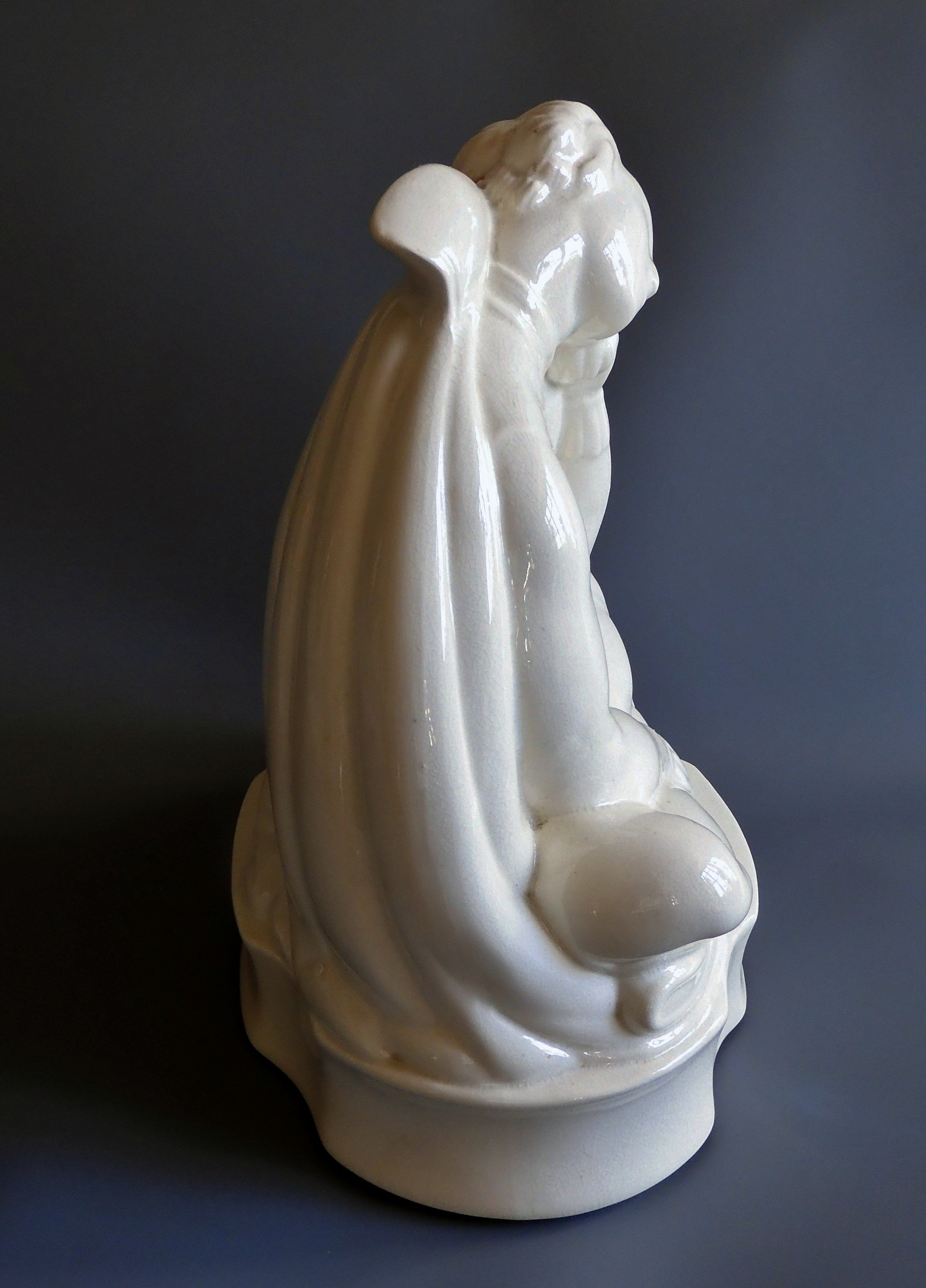
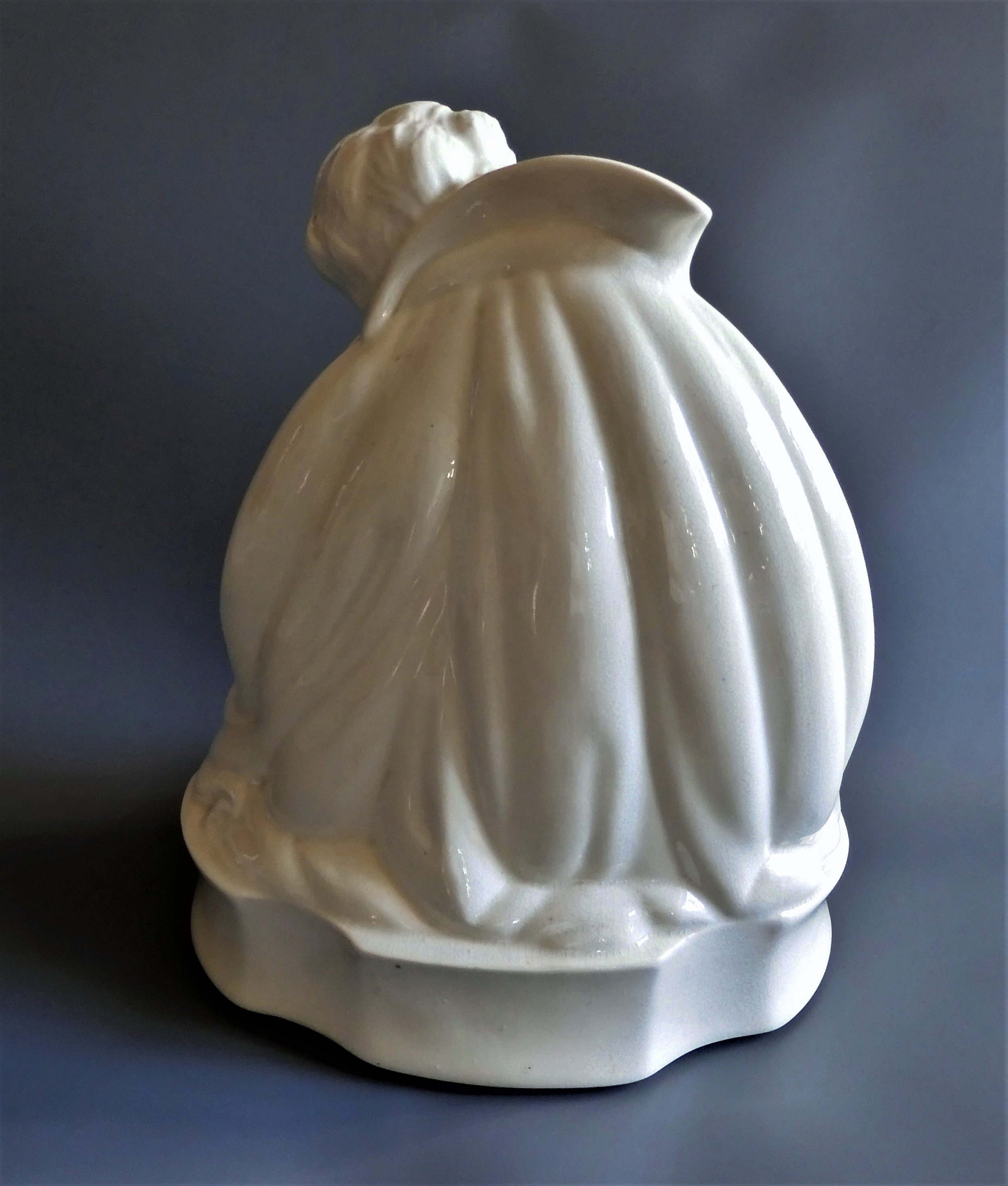
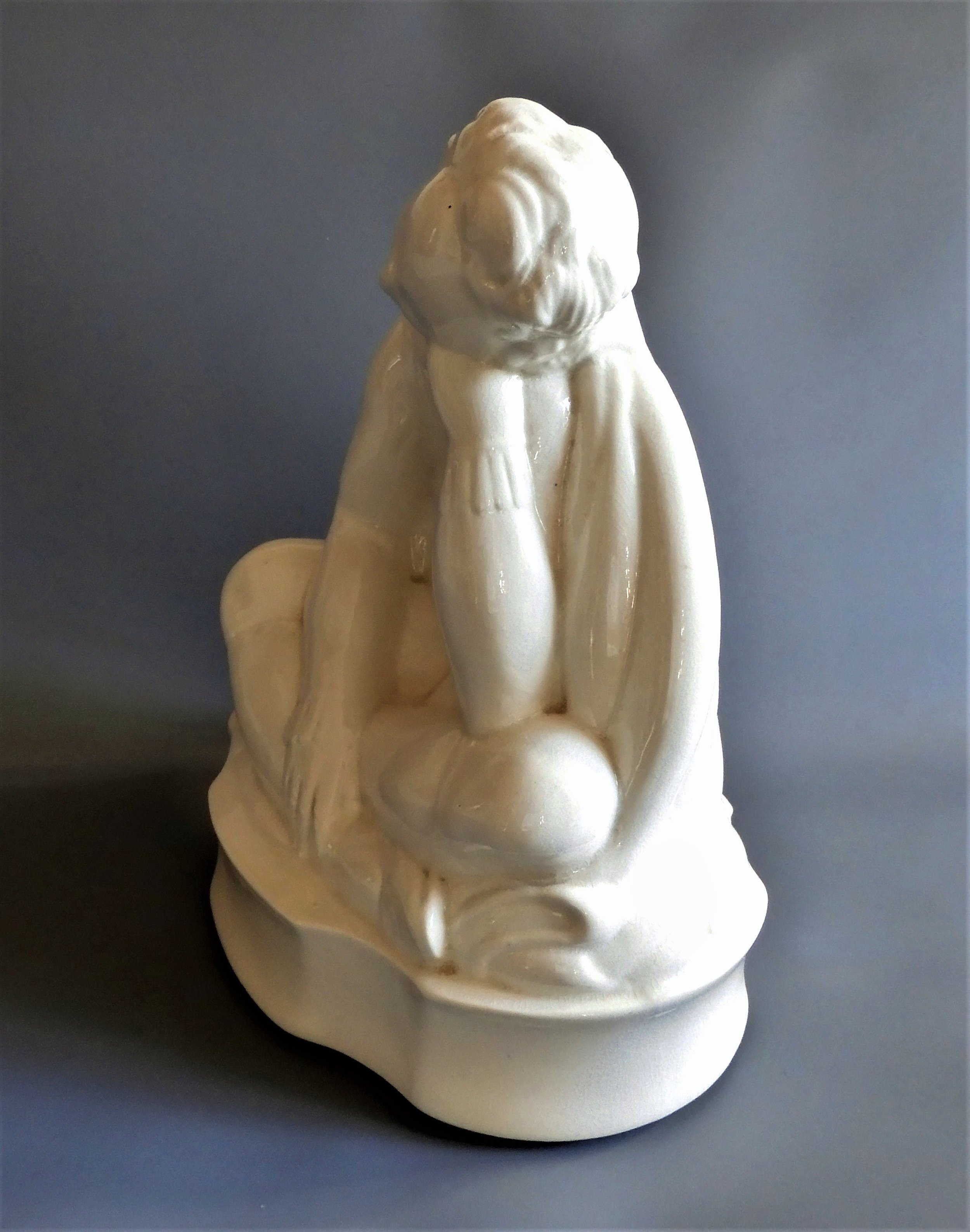
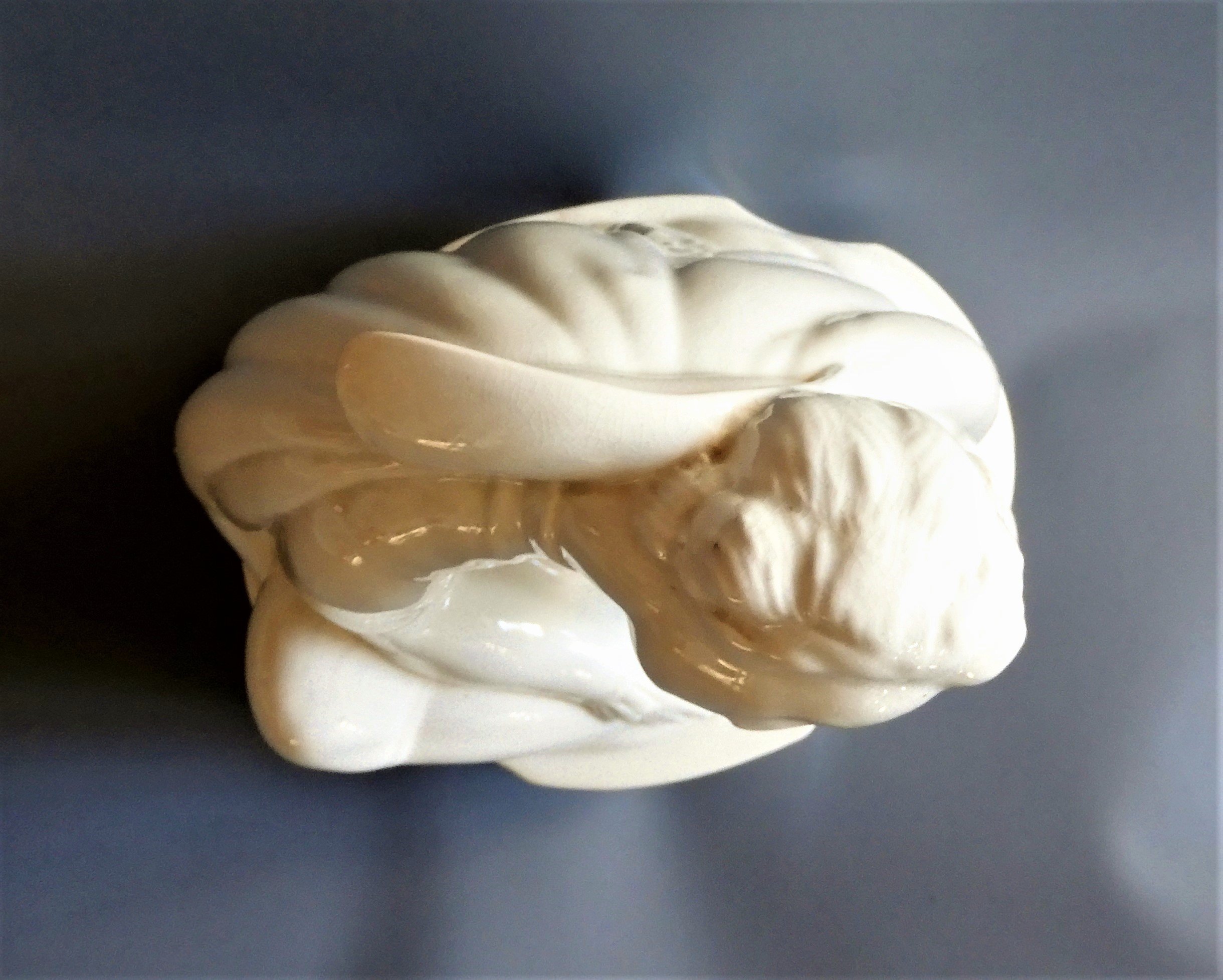
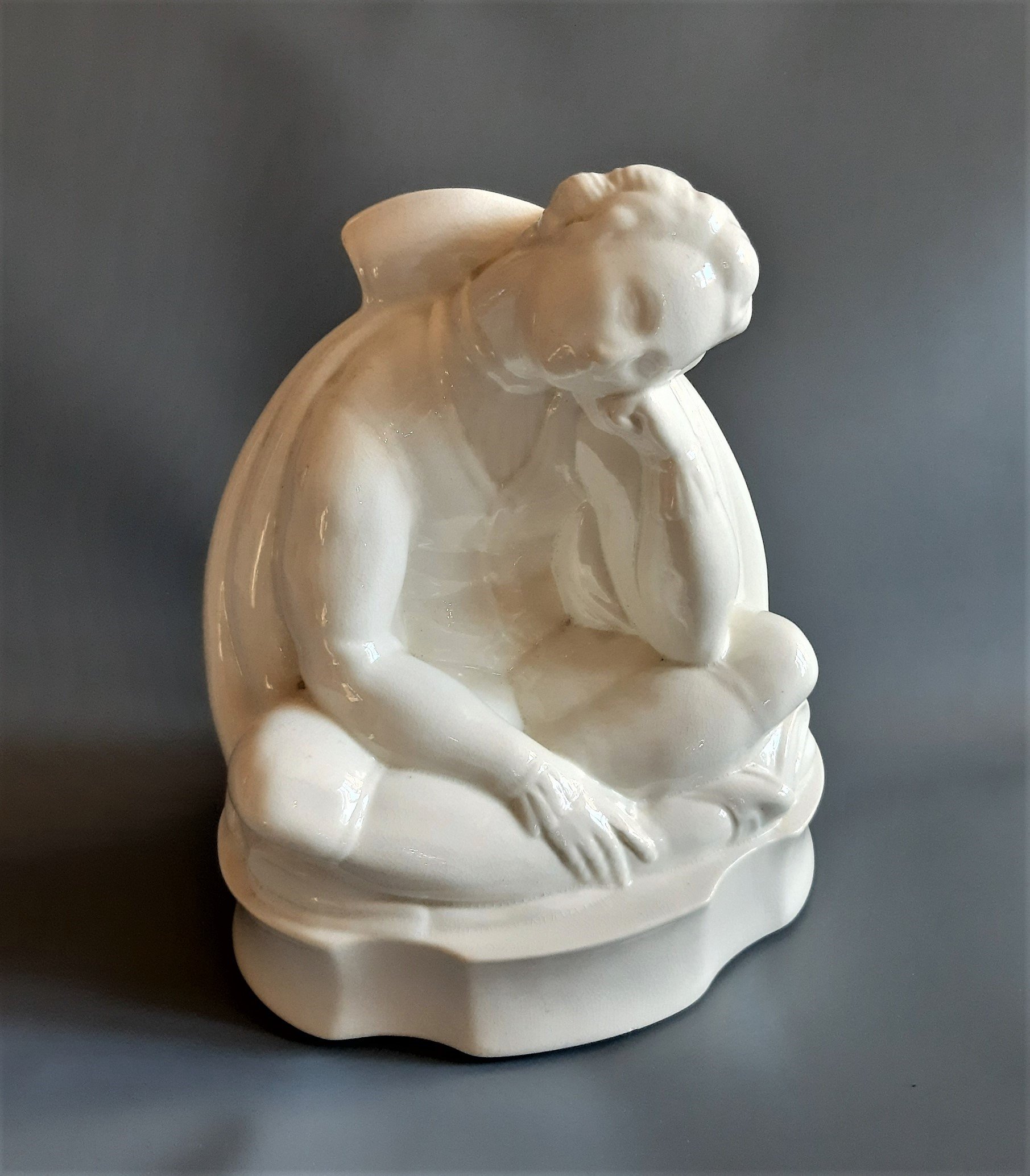
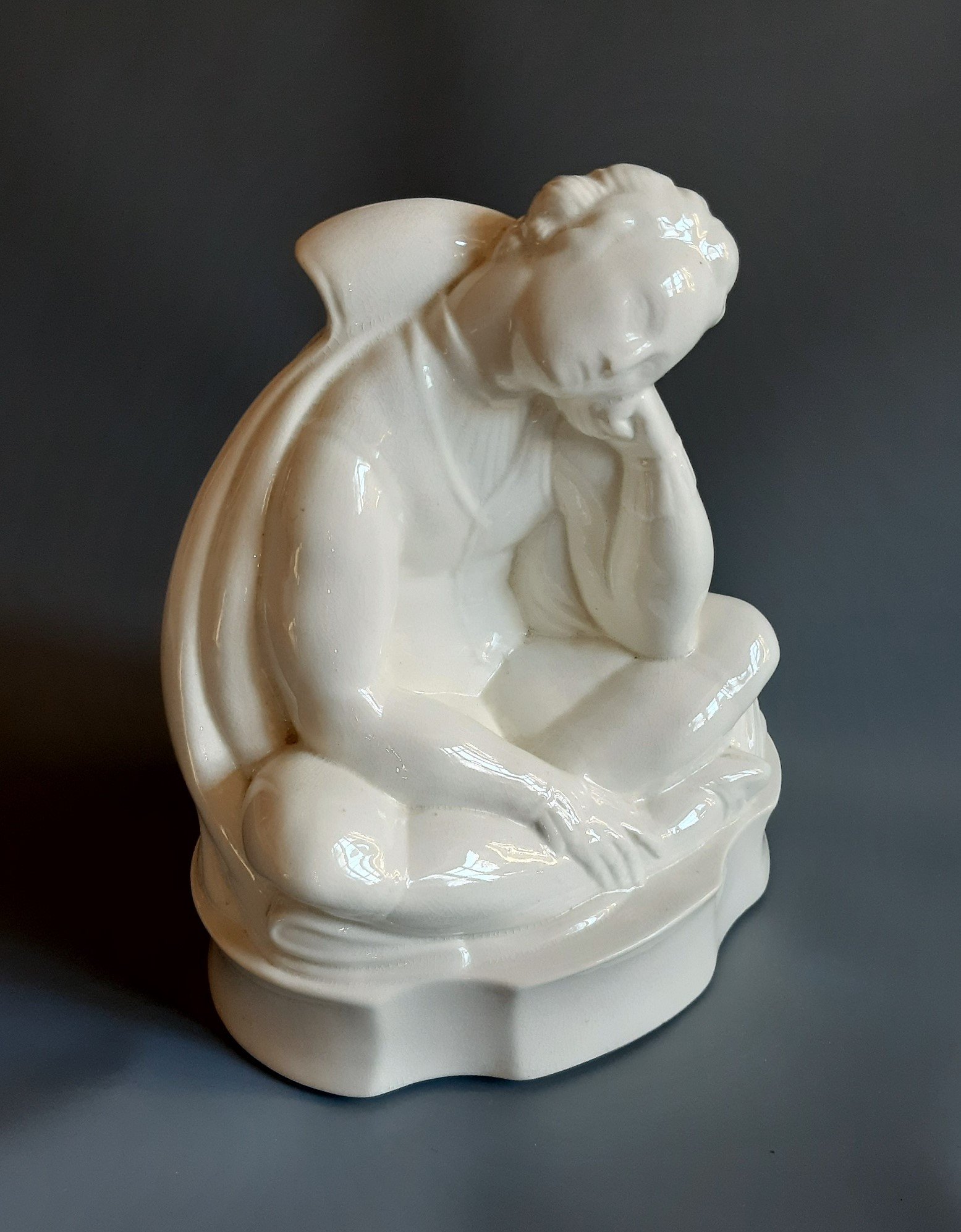

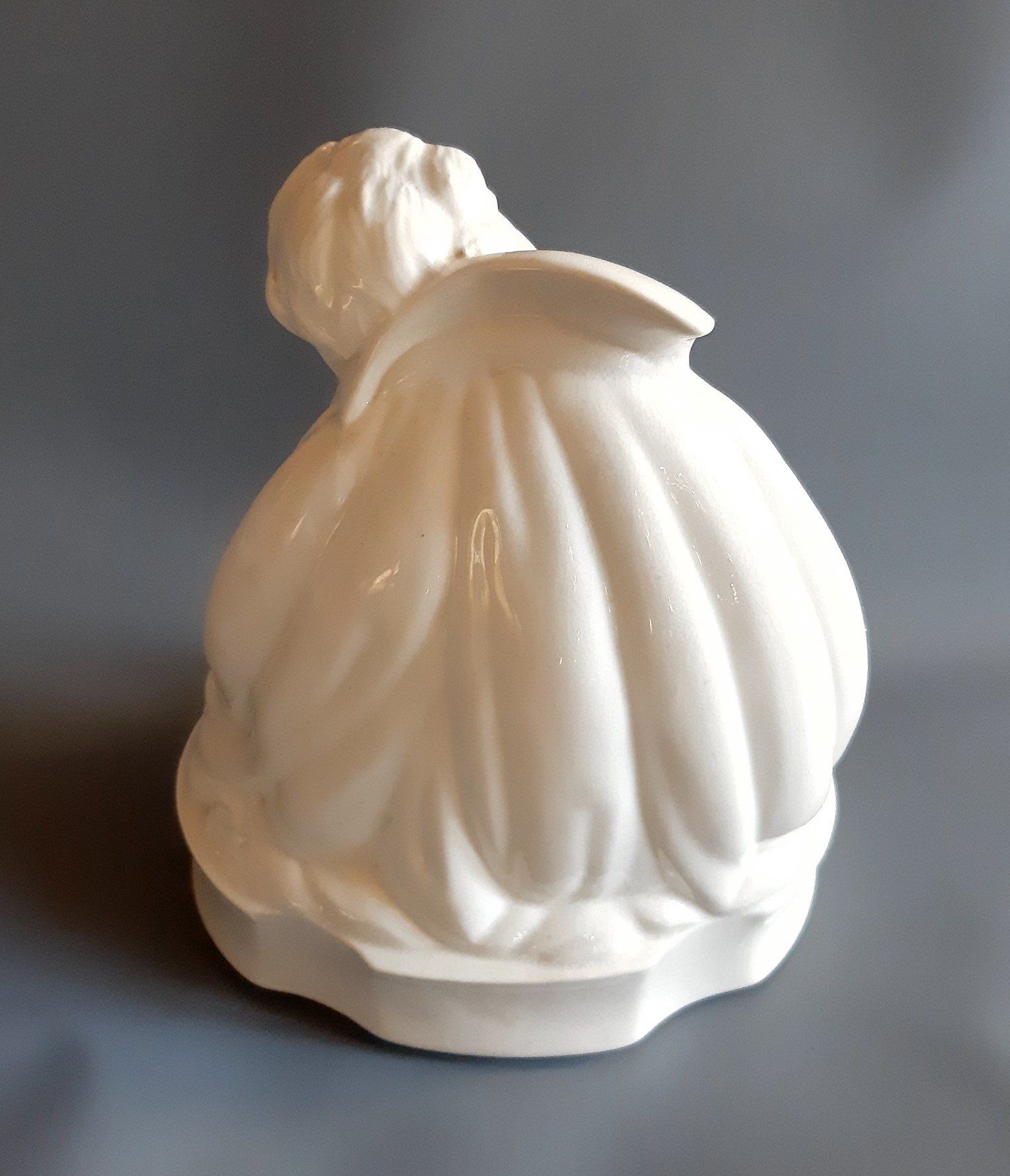
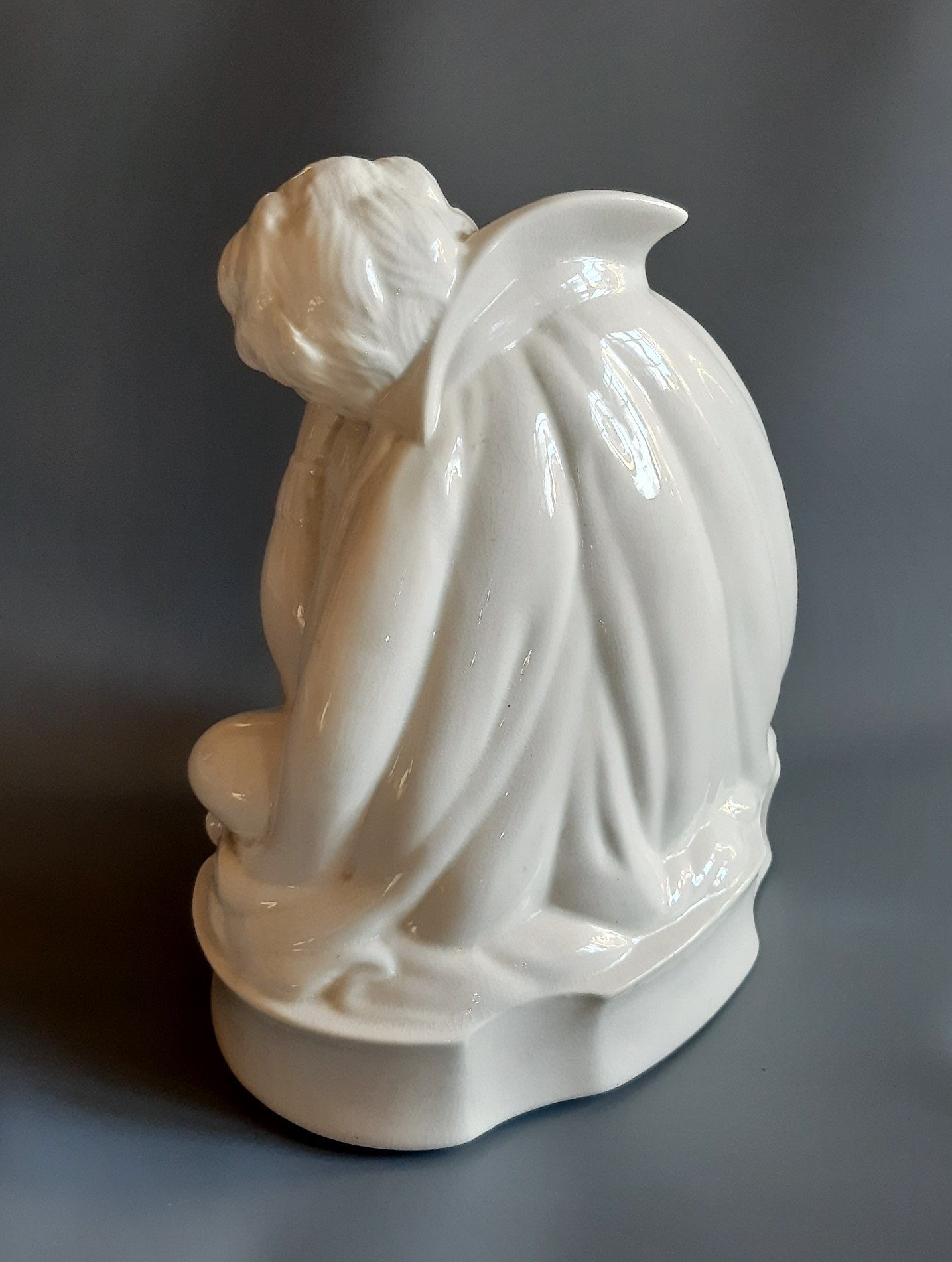
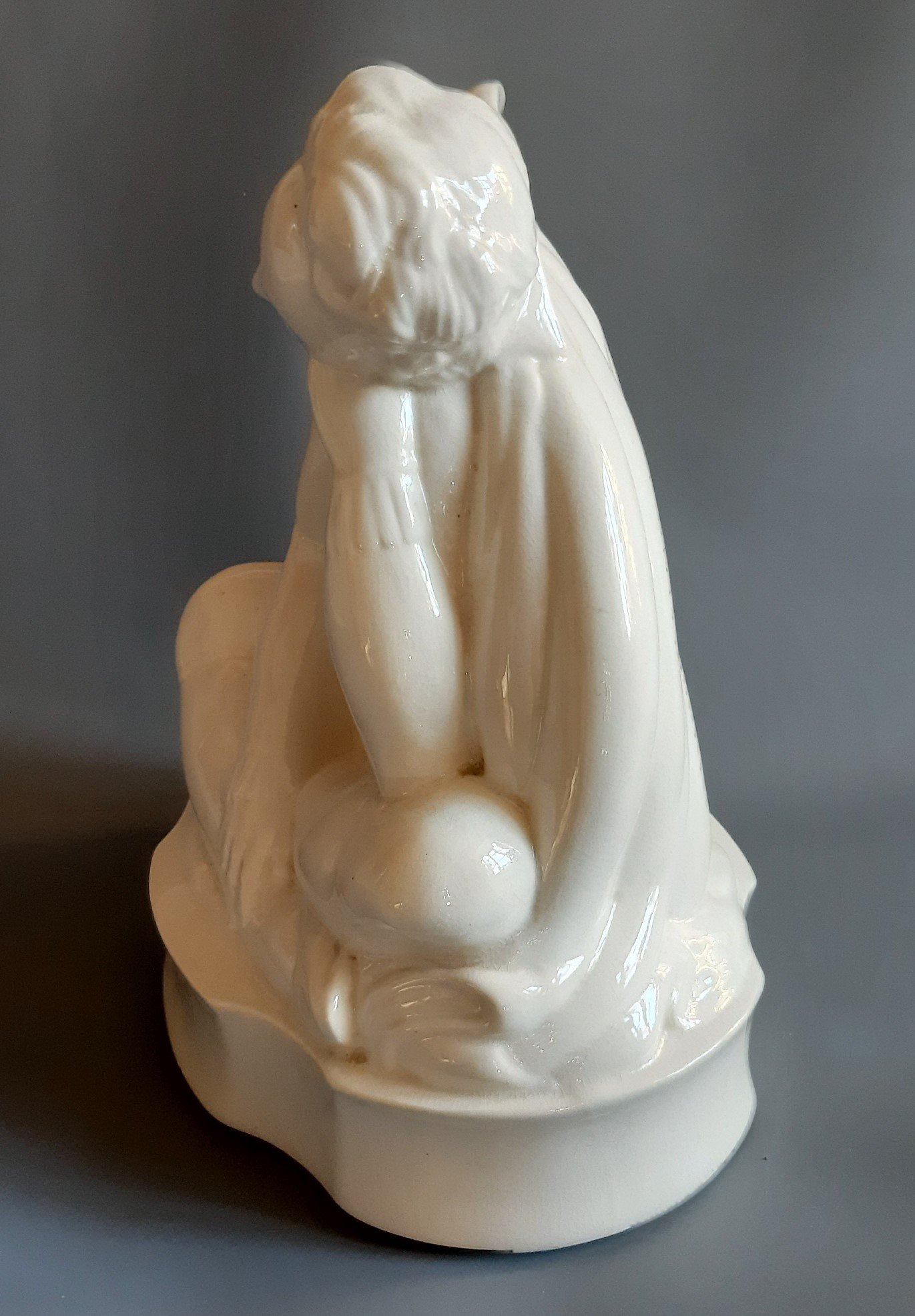

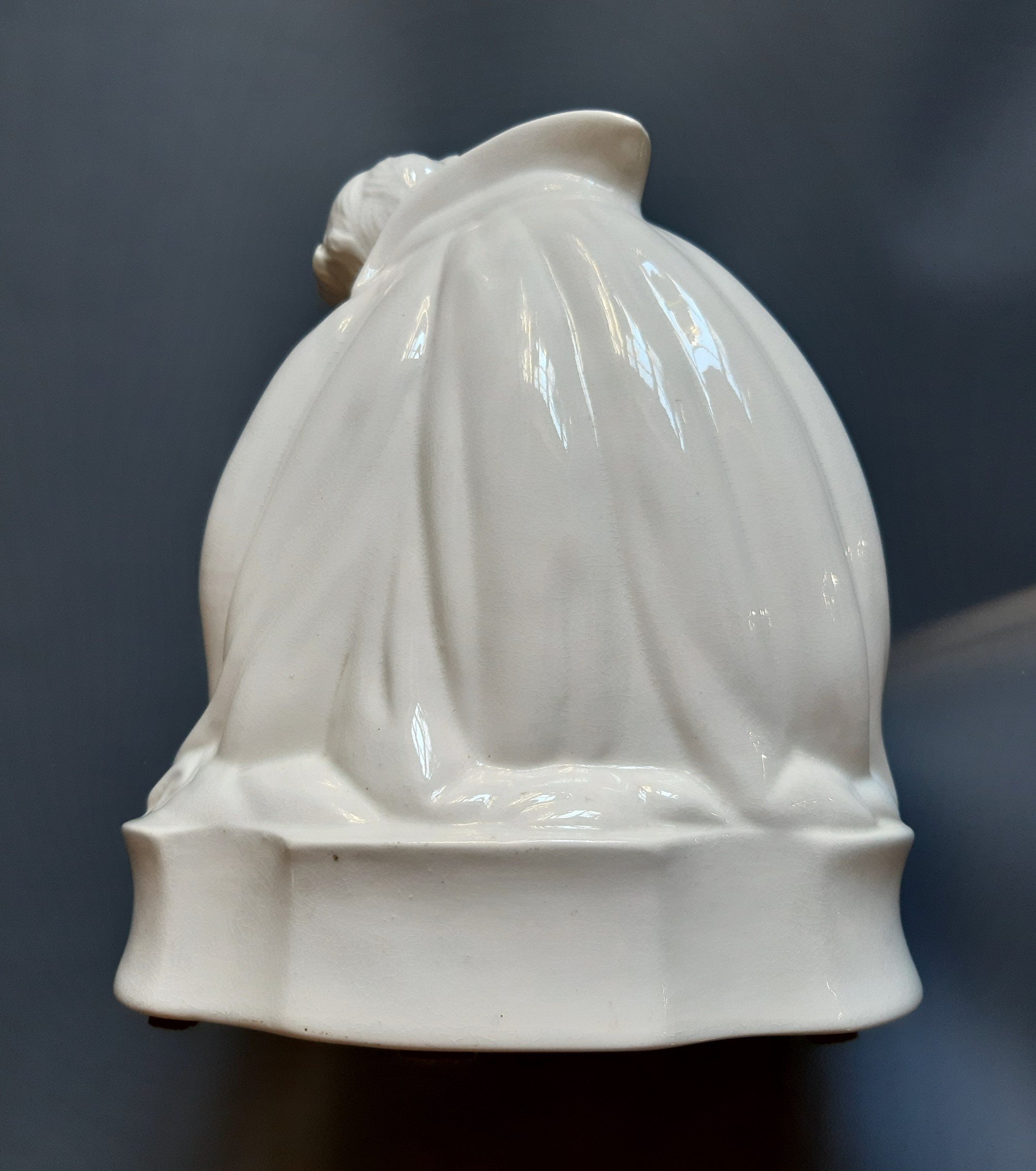
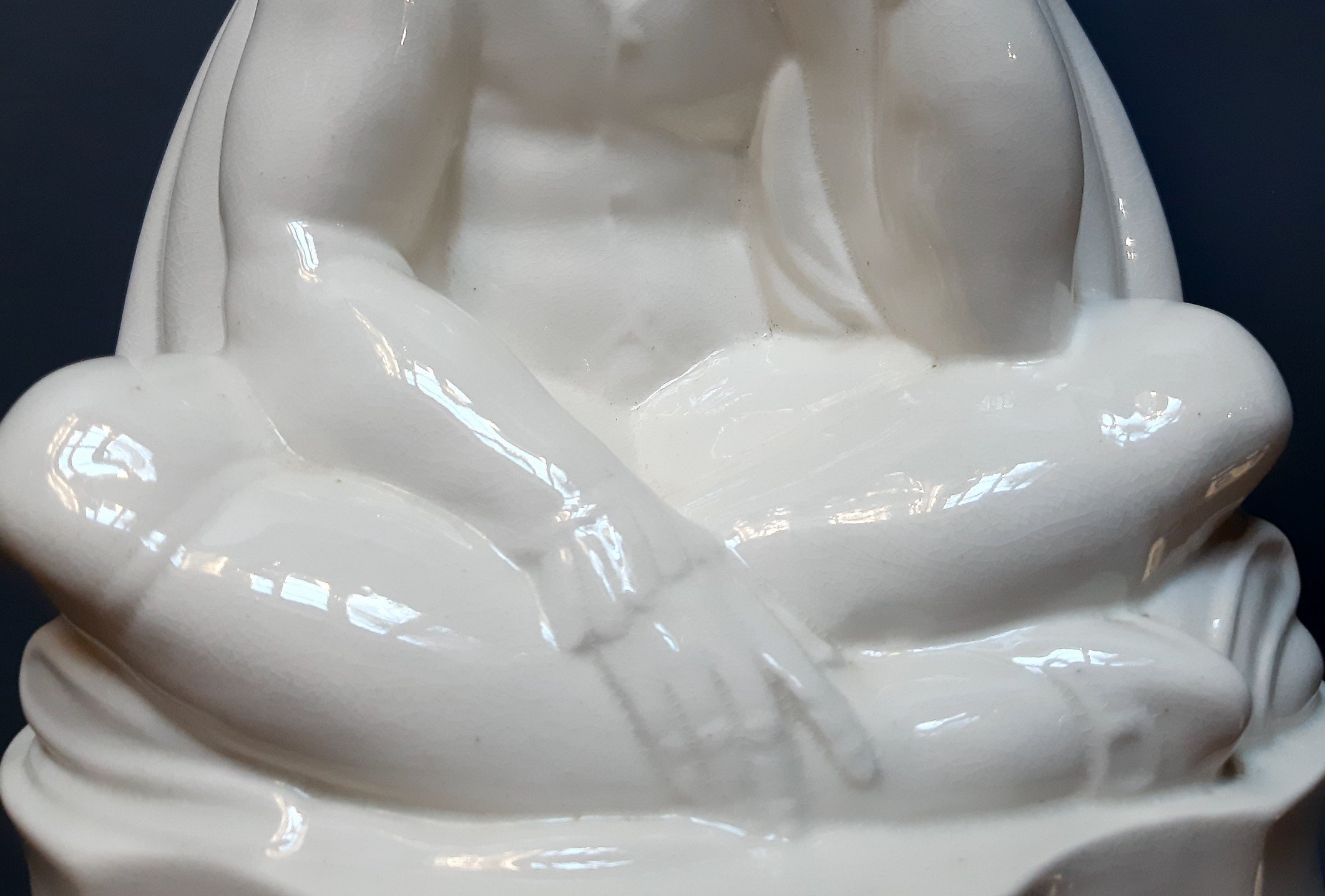

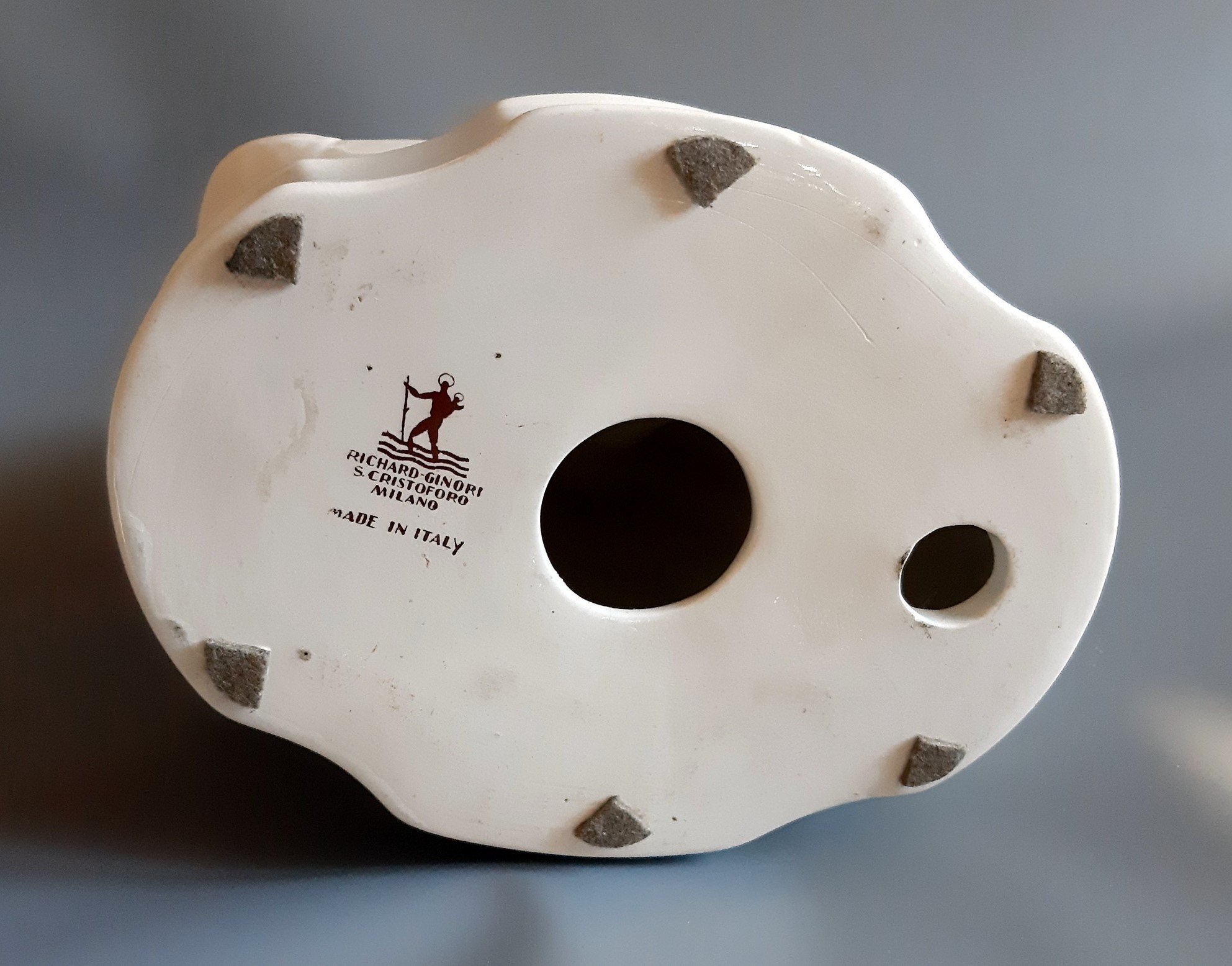
Sculpture modeled by Salvatore Saponaro, based on design by Gio Ponti.
Marked 'Richard-Ginori S. Cristoforo Milano Made in Italy' with the graphic symbol of the manufacturer. Excellent antique condition, wear consistent with age and use.
Dimensions: Height: 25cm Width: 21cm Depth: 16cm
The sculpture depicts a male figure with his head reclined and resting on his left hand, sitting cross-legged on a base. The model of the tired pilgrim was exhibited at the Second International Exhibition of Decorative Arts in Monza, in 1925. The traits of the character refer to the figure of the resting traveler, also presented in many sculptures produced in the eighteenth century by Felice Clerici's Milanese factory. The success achieved by this particular iconographic subject is also testified by the large series of tiles and vases that reproduce not only the pilgrim, but also different varieties of "tired figures"; such as a hunter, a sailor, a player, a reader, a smoker and a gardener. The earthenware maintains the same playful and ironic spirit, made modern and light by the essential line and the rounded shapes. It has become an icon of the great Milanese architect, Gio Ponti.
Gio Ponti (Italian, 1891-1979), an Italian designer, architect and editor was one of the most influential design visionaries of the 20th century. Ponti designed a wide array of furniture and products through his career - from cabinets, lamps and chairs to ceramics and glassware - and his buildings, including Pirelli tower in Milan, and Denver Art Museum, were erected in 14 countries.
Through Domus, the design magazine he founded in 1928, Ponti promoted a new curiosity and open-mindedness towards new design thinking. Today, a wide range of Ponti's designs are snapped up by savvy collectors who want to give their homes a touch of Italian panache and effortless chic.
Gio Ponti was a conceptualist who always drew lines between the architecture and the interior design. Ponti never viewed architecture as simply creating buildings. Instead, he often conceived of the building's interior as well; creating furniture, lighting appliances, and even ceramics, glassware and silverware to fit the overall concept. His design was influenced by la dolce vita; he encouraged everybody to use good design to enjoy life to the fullest. This exact colourful, joyful, sensual Italian good life is reflected in his portfolio, and will certainly continue to influence artists and designers well into the future.
Today, a wide range of Ponti's designs are snapped up by savvy collectors who want to give their homes a touch of Italian panache and effortless chic.
Literature
Richard-Ginori Ceramic Society, Modern Art Ceramics
Richard Ginori, Milan, 1930, p. 110
Ugo La Pietra, Gio Ponti, Rizzoli, Milan, 1995, p. 30
sold
Roberto Rosati
ITALIAN FUTURISTIC Art Deco
Wall Plate
Majolica, ca. 1930s
This large and stunningly beautiful hand-painted futuristic Art-Deco majolica wall plate by famous Italian ceramist, Roberto Rosati depicts a peasant woman in a sunlit field during harvest. Gracefully bending down, with a disobedient lock of hair knocking out from under her kerchief, she cuts off handfuls of wheat with a sickle. This unique plate possesses several outstanding qualities at once - most unexpected artist's vision, elegant minimalistic composition and discreet decorativeness, exceptional workmanship and, especially, a non-trivial color palette of brown, black and white silhouette of a peasant woman against background of gold and pale yellow semi-opaque paints laid on ceramic surface with bold and precise strokes of a real master; thus creating an illusory effect of iridescence.
ATTRIBUTION: Signed (front center) with stylized monogram “R” and inflorescence of shamrock below; and (back) “R SCVOLA D’ARTE GIROTTAGLIE”.
DIMENSIONS: Diameter: 18.5 inches (46.25 cm) Height: 1.5 inches (3.75 cm)
CONDITION: The plate is in good antique condition, wear consistent with age and use. However, a museum-quality restoration is present – as the frontal surface of the plate looks perfect, without any visual restoration traces; the back of the plate shows obvious traces of previously executed restoration, probably done no less than at least 50-60 years ago.
ROBERTO ROSATI (Rome, 1889 – 1949), a native of Rome, was one of the most talented ceramists of his generation, following the futuristic direction in art. In 1925, Roberto Rosati was called by Giuseppe Rodriguez, famous Roman ceramics maker and school owner to teach artistic ceramic painting in his laboratory and the ceramic school, located in Rome at via S. Maria in Cappella, 11; where he taught for several following years. Despite the heavy workload and being constantly surrounded by numerous students, he nevertheless finds time for creation of his own very original works, and participation in exhibitions.
The peculiarity of the Italian art "production" of the interwar years, which is best known, is its comparative liberality against the background of Germany and the USSR. The Futurists were among the first supporters of Benito Mussolini and therefore could work as they wished; rationalist architects close to the international modern movement also received government orders; as well as adherents of metaphysical painting, "Novecento", who coexisted with them very well.
In 1937, Roberto Rosati, already a venerable and well-known ceramist by that time, was invited to take the position of director of SCUOLA D'ARTE GROTTAGLIE, founded in 1887. Still in existence today, it is now called Istituto d'Arte Grottaglie (via Jacopo della Quercia, 1, 74023 Grottaglie, Puglia, Italy). For centuries, Grottaglie, a small town in the province of Taranto in Puglia, has been the site of flourishing artisanal ceramic production closely linked to the richness of the clay typical of this region. The art of ceramics in Grottaglie has a very long history, as demonstrated by the magnificent finds displayed in the local Ceramics Museum, with its roots stretching back to the Medieval period. Figurine ceramic craft, which was the driving force of life and commerce in Grottaglie for centuries, is represented in the museum by approximately 400 items spanning a time period from the eighth century B.C. to the present day.
The years spent by Roberto Rosati as school director until his death in 1949 fell on a very important historical moment in Italian history - the heyday and further decline of the dictatorial fascist rule of Mussolini; which was also one of the brightest periods since the Renaissance in the development and formation of Italian art in the future. For a long time, there was no talk at all about the official style of the regime, and there was always a varied private order. However, it should be remembered that rationalists emphasized their connection with tradition, which was unimaginable for most foreign modernists of those years, and futurism after the First World War changed significantly, changing the "composition of participants" and becoming less radical and ready to create according to the demands of the time. Time called for "return to order" throughout Europe. But it was in Italy that this appeal to tradition, reality, and history acquired distinct features of "construction", which can be compared with postmodern experiments, up to irony, for example, in arts and crafts in general and in ceramics in particular.
But even quite serious artists, such as, Rosati, who claimed a unique sense of taste, form, beauty inherent only to Italians, and reminded of the achievements of the Renaissance masters, eventually created conglomerates, where it is clearly read: the time of the "classics" has irrevocably passed away already in the 1920s. Everyday Italians, as well as intellectuals referred to the great Italian art of the past, but each time you look at these statues and canvases, one does not leave a feeling of the artificiality of this play of forms, postmodern "modernization" of the classics. And here the perspective is clear further - to post-war, often more lively and honest experiences.
$7,700
American Streamline Moderne
Marianna von Allesch
Ceramic Cigar Ashtray
Ca. 1940’s
Dimensions: Length - 8.5” Width - 5.5” m Height - 2.75”
Excellent vintage condition. No damages, scratches or chips to report. Wear consistent with age and use.
Marianna von Allesch (German-American, 1886–1972) was born Maria Anna Steudel in Germany. Von Allesch emigrated to the United States in 1928, and by the late 1940’s had established herself as a formidable creative force (in multiple media, most notably ceramic and glass art) that was as admired by curators and fellow artists as she was by interior designers and collectors. Maria Anna Steudel trained under Bruno Paul and Adelbert Niemeyer and at the Royal Academy of Arts (now merged in the University of the Arts in Berlin ) in the fields of painting , ‘arts and crafts’ and textile design. She was particularly taken by the art of glass blowing and ceramics in the years following university.
After marrying Gustav Johannes von Allesch, a psychologist from a noble line, she set up a boutique called ‘The Blue House” at Kurfürstendamm, 244 in Berlin; where she sold her embroidery, textiles and glass sculptures in the early to mid-1920s. In 1928, after a divorce from her nobleman husband, she decided to leave Germany for the USA. Maintaining her married name, von Allesch lived mostly in New York City, where she initially ran a studio on East 68th Street. She became known for her avant-garde asymmetrical ceramic pieces, often monumental in size, that were wired as table lamps, as well as her glass sand ceramic bowls, ashtrays and large-scale ceramic wall reliefs (ceramic murals). She eventually became the glass designer for Kensington Crystal Co. and designed the successful furniture line Pulaski Modern Furniture, becoming a known interior designer (for Pulaski Veneer Co. in Virginia) and academic (at the Minneapolis Institute of fine arts) in the decade that followed.
In 1956, Marianna von Allesch was commissioned to produce the lamps in the lobby and in the over 400 rooms of the newly built Americana Hotel in Bal Harbor, Miami , designed by architect Morris Lapidus. The hotel was renamed Sheraton Bal Harbor Miami in 1980 and blown up in 2007 in favor of new buildings. The works of Marianna von Allesch were shown in exhibitions and museums in Europe and the USA. The Princeton University Art Museum and the Metropolitan Museum of Art in New York also acquired some works for their collections. Marianna von Allesch died in 1972 in Elmsford, Westchester County, New York.
SOLD
Arts & Crafts
Thomas Forester & Sons
A Pair of Vases with Peakocks
Glazed Terracotta, Ca. 1900
Dimensions:
Height: 14-1/2 inches Diameter (top): 4-1/8 inches Diameter (bottom): 6-1/2 inches
Thomas Forester & Sons Ltd. (England, active c. 1877-mid-20th c.) — A prominent Staffordshire pottery house known for high-relief majolica and Phoenix Ware art-pottery. Signature motifs include peacocks, cranes, foliage and richly glazed surfaces. Makers’ marks may include “T.F. & S.”; many pieces are unmarked but attributed on style and provenance.
$2,900 per set
Mid-Century Modernism
Stanley Stangren
Nude
Decorative Hand-Painted Ceramic Plate
1955
Signed by the artist and dated ’55 lower left.
Dimensions: 14.5” diameter x 1” depth
Stanley R. Stangren (1928 – 2014) was an American jeweler, artist, sculptor and ceramist, residing in New York City. He worked in different styles and in different materials, including oils, watercolor, ceramic and stone sculptures; and fine jewelry. Stangren’s painting styles varied tremendously – from complete abstract works to Holocaust themes in the style of Georges Rouault and Hieronymus Bosch to portraits in the style of Moses and Raphael Soyer.
He was also a passionate lover of the performing arts, and, as a young man, spent time studying dance at both the School of American Ballet and with Martha Graham. Although he worked with dance pioneers like Ms. Graham, Anna Sokolow and Charles Weidman, an injury prevented him from pursuing dance as a career. But he found other outlets for his artistic pursuits.
In his youth, Stangren attended the Brooklyn Museum School of Art, and graduated from the High School of Music and Art in New York City. He later studied at the Boston Museum of Fine Arts, the Art Students League, Bard College and in Europe.
Stangren studied jewelry design in Europe, attending Staatlische Kunst Werkschule in Pforzheim, Germany and Kunstgewerbeschule der Stadt in Zurich, Switzerland.
His jewelry and designs were received with great success. His combination of precious and semi-precious stones, high-karat gold and sterling silver, and exotic materials executed with outstanding workmanship in the abstract modernist style gave a unique aspect to his designs, the metalwork usually electroformed, cast, or fused in varying textures.
After returning to New York in the later 1950’s, Stangren opened and maintained a ceramic business in Trenton, New Jersey. Very few pieces of his work remain from this period.
When he retired from the ceramics business, he spent much of his time enjoying the arts. He frequently attended Juilliard performances, including most of the opera and drama presentations at the School, and was especially fond of the dance concerts.
The last 40 years of his life, he taught painting in the New York area and worked with Metropolitan Museum of Arts in developing annuities, for future acquisitions. Inb addition, Stangren left annuities for MoMa in support of educational programs and left, in his will or through his execuitors, art supplies for the Harlem School of Art and benefits for the Urban Assembly organization.
Mr. Stangren's love for the arts and for the performances he was seeing at Juilliard inspired him to take his participation a step further and to establish charitable gift annuities with the School. "I realized what Juilliard offered me, being a passionate music lover, and I decided to give something back" he said. "What Juilliard achieves is remarkable. When I think of the prominent actors, dancers and musicians that have been educated there, I am always staggered. It is deeply financially satisfying to be able to give back to the School, while benefitting from it at the same time."
The Juilliard School is not the only organization that Stanley Stangren supported. He has established gift annuities at a number of other nonprofits, including the Metropolitan Museum, the American Civil Liberties Union, the Children's Aid Society and the New York City Opera.
sold
Antique
Bust of Cape Verde Island Native
GLAZED TERRACOTTA
Portugal, ca. 1875
Dimensions:
Height: 12 1/8 inches Width: 7 inches Depth: 4 1/2 inches
This exquisite and very unusual sculptural majolica bust of a woman, wearing a coral necklace and a bright headscarf made in the last quarter of XIX Century on the Portuguese colonial island of Cape Verde. Due to the peculiarities of the material and realistically rendered image, the skillfully selected colors under the well-preserved glaze are still pleasing to the eye with their brightness and freshness, creating an amazing life-like effect. Though clearly marked on the bottom with a circular crest and a bee (fly?) on top, we could not establish the name of the artist/maker.
sold
French Art Nouveau
THISTLES & LIZARDS
Grand Majolica Vase
Ca. 1900
Dimensions: Height: 21 1/2 inches Max width: 12 1/2 inches
This beautiful grand and highly decorative Art Nouveau ceramic vase is outstanding by all measures. It is fabulously rendered in the most unusual technique, combining a hand painted thicket of life-like thistles flowers with overlaid leaves and lizards crawling among them. The two handles on the top of the vase are formed by the curled tops of the large thistles leaves, it's beautiful organic lines very characteristic of the French Art Nouveau aesthetics.
$3,700





































